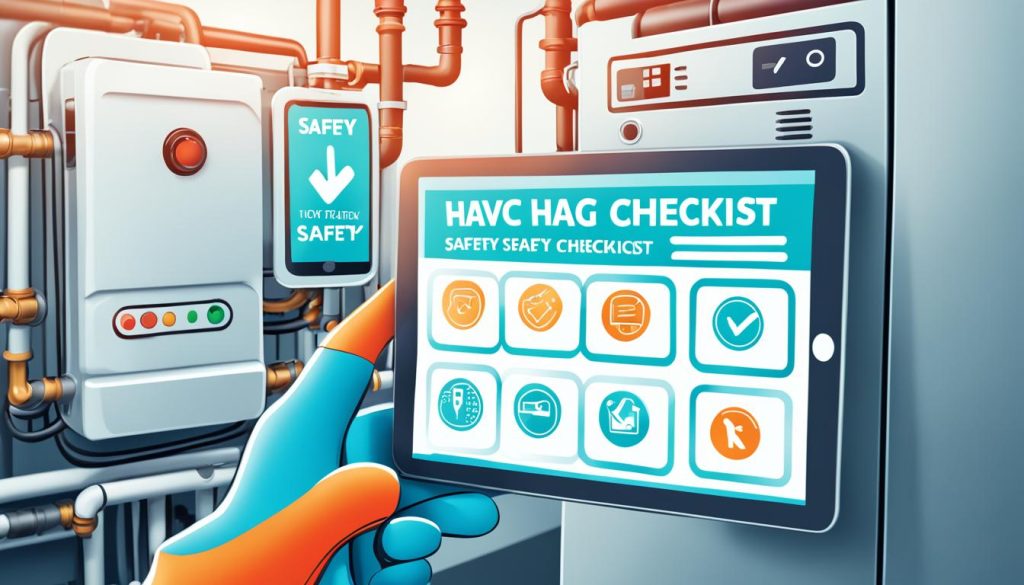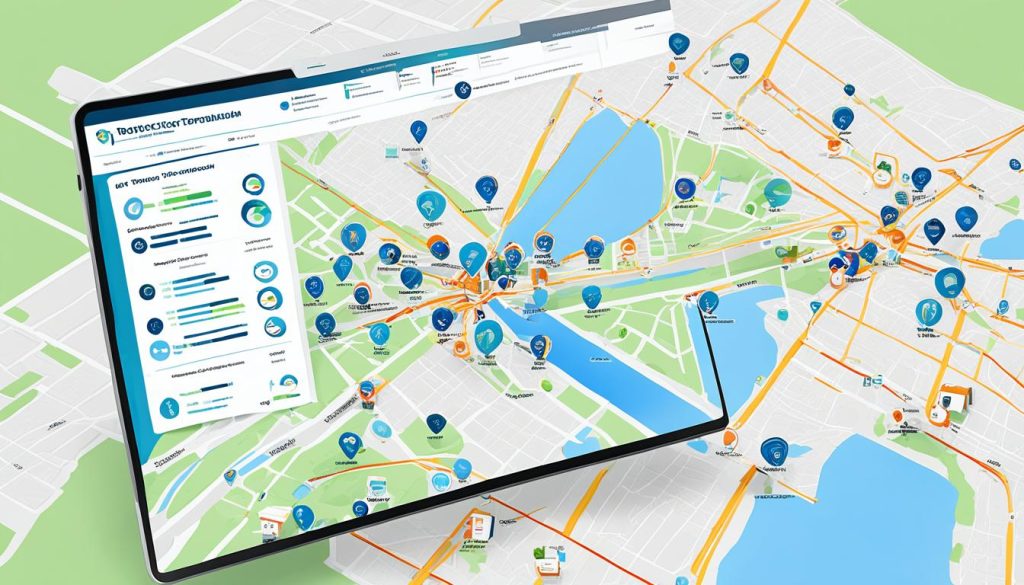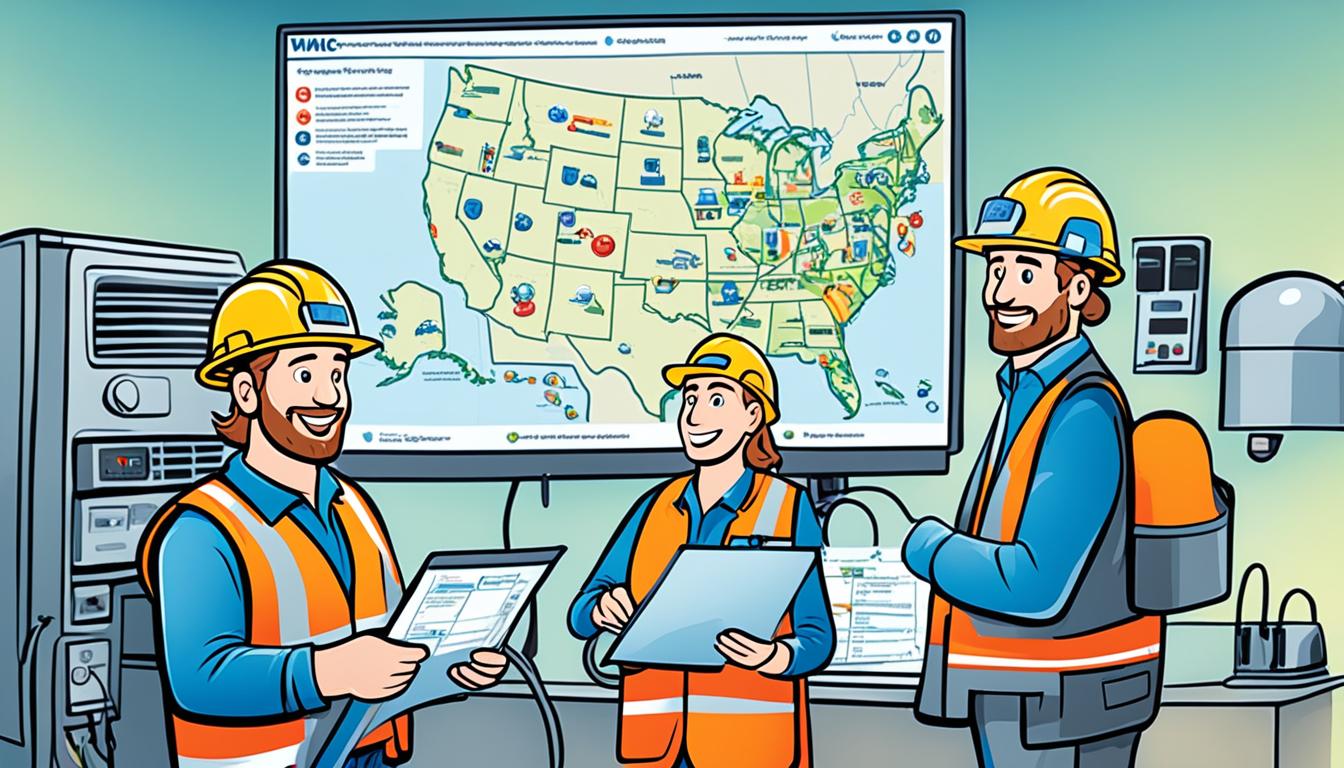Using dispatch software can make HVAC safety compliance better. These tools make operations smoother, automate schedules, and include important safety steps. With field service management software, you get more control over tracking compliance and make sure your technicians follow safety rules.
Modern dispatch software does more than just assign jobs. It gives technicians quick access to customer info, equipment details, and job instructions. This approach cuts down on paper and manual data entry. It helps your team work faster and more accurately, sticking to HVAC safety rules.
Adding digital checklists and safety steps to your dispatch software builds a strong system for staying compliant. These features make sure technicians do all safety checks before they’re done with a job. This creates a solid record for audits and boosts safety in your HVAC work.
Understanding HVAC Safety Compliance Challenges
HVAC technicians face many safety risks every day. They deal with electrical dangers and chemical exposure. It’s important to know these risks to keep technicians safe and follow the rules.
Electrical risks are a big concern in HVAC work. Things like bad wiring and high-voltage equipment can cause serious harm. It’s key to have the right training and use insulated tools to stay safe.
Chemicals are another big risk. HVAC work often involves harmful substances like refrigerants and solvents. These can be dangerous if not handled right, so it’s important to use protective gear.
Respiratory risks are common in HVAC. Things like dirty filters and mold can harm your lungs. Keeping systems clean and using respirators is crucial for protecting technicians’ health.
Falls are a leading cause of injuries for HVAC workers. Working on ladders or roofs means following safety rules and using the right gear to prevent falls.
| HVAC Safety Hazard | Compliance Requirement | Safety Measure |
|---|---|---|
| Electrical Hazards | OSHA Electrical Safety Standards | Insulated tools, proper lockout/tagout procedures |
| Chemical Exposure | EPA Refrigerant Handling Regulations | Personal protective equipment, proper ventilation |
| Respiratory Risks | NIOSH Respiratory Protection Guidelines | Respirators, regular air quality testing |
| Fall Dangers | OSHA Fall Protection Standards | Harnesses, guardrails, safety training |
Knowing about these safety issues helps your HVAC team get ready for the job. It helps them follow the rules and stay safe at all times.
The Role of Dispatch Software in HVAC Operations
Dispatch software is key to making HVAC operations run smoother. It automates important tasks and boosts efficiency. Let’s see how this tech changes HVAC businesses for the better.
Streamlining Scheduling and Job Assignment
Dispatch software makes scheduling technicians easy. It matches technicians with the right jobs, ensuring the best fit for each task. Urgent jobs get handled fast, thanks to automated job prioritization. This means less downtime and better service quality.
Improving Communication Between Office and Field Teams
Real-time monitoring changes the game for HVAC teams. Office staff can see where technicians are and what they’re doing. This means better coordination. Technicians get updates on their jobs right away, cutting down on mistakes.
Enhancing Customer Service and Satisfaction
Dispatch software takes customer service to the next level. It gives customers accurate times when technicians will arrive. Some systems even let customers track their technician’s location in real-time. This clear communication builds trust and makes customers happier.
| Dispatch Software Feature | Benefit to HVAC Operations |
|---|---|
| Automated Scheduling | Optimized technician utilization |
| Real-time Monitoring | Improved coordination and response times |
| Customer Tracking | Enhanced transparency and satisfaction |
| Route Optimization | Reduced travel time and fuel costs |
Key Features of HVAC Dispatch Software for Safety Compliance
HVAC dispatch software has key features that boost safety in your work. These tools make processes smoother, cut down on risks, and help follow safety rules.
Safety protocol integration is a key part of modern dispatch software. It puts safety steps right into work orders, helping technicians do their jobs safely. This makes sure safety isn’t forgotten, even when things get hectic.
Compliance tracking is also crucial. The software checks if you’re following safety rules and alerts you to any problems. This lets supervisors fix issues fast, keeping the workplace safe.
Automated reporting makes keeping records easy. The system creates detailed reports on safety, equipment, and rule following. These reports are key during audits and help spot areas to get better.
Digital safety checklists change the game for HVAC techs. These lists make sure all safety checks are done before a job is finished. They remind techs of safety rules and keep a record of following them.
| Feature | Benefit | Impact on Safety |
|---|---|---|
| Safety Protocol Integration | Embeds safety procedures in workflows | Reduces oversight of safety measures |
| Compliance Tracking | Real-time monitoring of safety adherence | Enables quick intervention for safety issues |
| Automated Reporting | Generates detailed safety performance reports | Simplifies audit processes and identifies improvement areas |
| Digital Safety Checklists | Ensures completion of all safety checks | Creates a verifiable record of safety compliance |
Automated Scheduling and Technician Matching
HVAC dispatch software changes how companies give out tasks and manage their teams. It uses smart algorithms to make things run better, focusing on safety and efficiency.
Skill-based Assignment for Qualified Personnel
Today’s dispatch software is great at matching skills with jobs. It looks at what technicians can do and what the job needs. This makes sure the right people do the right jobs, cutting down on safety risks and making work better.
Workload Balancing for Safety
It’s important to balance workloads for safety. The software spreads tasks evenly among technicians. This stops people from getting too tired or overwhelmed. It helps avoid accidents and mistakes caused by being too tired.
Dynamic Scheduling and Real-time Updates
HVAC dispatch systems can change schedules on the fly. They adjust for emergencies, traffic, and what’s most important. This keeps things running smoothly and safely, even when things change suddenly.
| Feature | Benefit | Impact on Safety |
|---|---|---|
| Skill Matching | Proper task assignment | Reduced errors and accidents |
| Workload Balancing | Even distribution of tasks | Decreased fatigue-related incidents |
| Dynamic Scheduling | Rapid response to changes | Improved emergency handling |
| Technician Qualifications Tracking | Up-to-date skill assessment | Ensured compliance with safety regulations |
By using these automated tools, HVAC companies can get better at following safety rules and work more efficiently.
Real-time Tracking and GPS Integration
GPS tracking has changed how HVAC dispatch works. It lets companies track where field technicians are in real-time. This helps improve efficiency, safety, and makes customers happier.
Dispatchers can see where every technician is with GPS tracking. This helps them make smarter choices when sending out jobs. It means the closest technician gets the job, cutting down on travel time and fuel costs.
GPS also helps with route optimization. Dispatch software looks at traffic and suggests the best routes. This saves time, cuts down on vehicle wear, and boosts productivity.
Monitoring technicians is more than just tracking their location. It shows how well they’re doing, like how long they’re at jobs, travel times, and if they’re on schedule. This info helps spot areas to get better and praise the best workers.
| Benefits of GPS Integration | Impact on HVAC Operations |
|---|---|
| Real-time location tracking | Improved dispatch efficiency |
| Route optimization | Reduced fuel costs and travel time |
| Performance monitoring | Enhanced productivity and accountability |
| Emergency response | Faster reaction to urgent situations |
Using GPS tracking with dispatch software makes HVAC companies work better. It leads to a more efficient, quick, and cost-saving service. This is good for both the company and its customers.
Digital Checklists and Safety Protocols
Digital checklists change the game for HVAC safety. They make it easier to follow safety rules and keep track of compliance. With these tools, your team will always know the safety steps to take.

Customizable Safety Checklists
Make your own digital checklists for HVAC tasks. They focus on the safety needs for various jobs. You can update them easily as new rules come out, keeping your team up-to-date.
Mandatory Safety Checks
Make sure all safety checks are done before finishing a job. This stops technicians from ending work until they’ve followed all safety steps. It’s a strong way to make sure your team follows safety rules all the time.
Historical Records for Audits
Digital checklists keep a detailed record of safety checks. Every checklist filled out is saved, showing how well your team follows safety rules. This info is key for inspections and helps you see where you can get better at safety.
| Feature | Benefit |
|---|---|
| Customizable Checklists | Tailored safety protocols for each job type |
| Mandatory Checks | Ensures all safety steps are completed |
| Historical Records | Simplifies compliance audits and inspections |
| Real-time Updates | Keeps safety protocols current with industry standards |
Equipment and Inventory Management
HVAC companies can boost safety by using dispatch software for managing equipment and inventory. This tech keeps track of tools, helps with safety gear, and schedules maintenance well.
Dispatch software tracks tools, making sure techs have what they need for each job. It keeps an eye on tool locations and conditions. This stops workers from showing up without the right safety gear.
Keeping an eye on safety gear is key for following the rules. The software warns you when it’s time to replace important items. This keeps a good stock of protective and emergency gear.
Setting up maintenance schedules is a breeze with dispatch software. It reminds you when to calibrate and service equipment. This keeps all tools up to standard, cutting down on downtime and boosting safety.
| Feature | Benefit |
|---|---|
| Tool Tracking | Ensures technicians have proper equipment |
| Safety Equipment Inventory | Maintains stock of critical safety gear |
| Maintenance Scheduling | Keeps equipment calibrated and serviced |
| Asset Management | Improves equipment lifespan and reliability |
Using these features makes your HVAC work safer, more efficient, and compliant. The software’s detailed approach to managing equipment and inventory prevents accidents. It cuts down on risks, lowers liability, and makes sure your team is ready for any job.
Enhance HVAC Safety Compliance Using Dispatch Software Features
HVAC dispatch software has powerful tools to make your operations safer. By focusing on safety, using data, and linking with other systems, you can make a strong safety system for your HVAC business.
Implementing Safety-focused Dispatch Processes
Set up your dispatch software to put safety first in job assignments. Think about the skills of technicians and the dangers of job sites when assigning tasks. This way, only the right people do the high-risk jobs, cutting down on accidents and boosting safety scores.

Leveraging Data for Continuous Improvement
Dispatch software gathers important safety data for review. Use this data to spot trends, find areas to get better, and tweak your safety plans. Checking safety data often helps you decide on training, updating equipment, and making processes better.
Integration with Existing Safety Management Systems
Linking your dispatch software with your current safety tools makes a full safety system. This link means safety records update in real-time, reporting is smoother, and tracking of safety metrics is better. By putting safety data in one place, you can keep a closer eye on compliance and act fast on any issues.
| Safety Feature | Benefit |
|---|---|
| Skill-based Assignment | Reduces risk of accidents |
| Data Analysis Tools | Enables continuous improvement |
| System Integration | Streamlines safety management |
Using these dispatch software features can greatly improve your HVAC safety compliance. Smart process design, data insights, and integrated systems create a strong base for keeping high safety standards in your HVAC work.
Training and Adoption Strategies for HVAC Teams
Getting your HVAC team to use new dispatch software well is key to safety. It’s all about planning and training. Let’s look at some strategies for training and onboarding your HVAC team.
Begin with a detailed onboarding program. It should teach both software use and how it boosts safety. Make training specific to roles like technicians, dispatchers, and managers. This way, everyone knows their role in the new system.
Include hands-on safety training. Show how the software fits with current safety rules. Use examples from real life to explain how it can stop accidents and make work safer.
Managing change is key to getting the software adopted smoothly. Tackle worries and doubts early. Talk about the good things the new system brings, like better efficiency and safer places to work. Listen to your team and change your plan if needed.
| Training Component | Purpose | Frequency |
|---|---|---|
| Software Basics | Core functionality understanding | Initial onboarding |
| Safety Features | Compliance enhancement | Quarterly refreshers |
| Advanced Tools | Efficiency optimization | Monthly workshops |
| Update Training | New feature familiarization | As needed |
Keep offering support and training as the software changes. Update your team on new features regularly. With ongoing learning, your HVAC team will always be up to date on safety.
Measuring the Impact on Safety Compliance and Performance
Dispatch software is key in tracking and boosting safety in HVAC work. It helps you understand your company’s safety level. This lets you make smart choices to improve safety.
Key Performance Indicators for Safety
Dispatch software tracks key safety metrics like incident rates and compliance scores. These KPIs show how well your team follows safety rules. By watching these numbers, you can find areas to improve and prevent accidents.
Analyzing Trends and Identifying Areas for Improvement
Performance analysis tools in dispatch software help spot safety data trends. This lets you see common issues or seasonal safety challenges. With this info, you can create plans to fix safety problems and increase compliance.
Reporting and Documentation for Regulatory Compliance
Dispatch software makes compliance reporting easy. It creates detailed reports that follow the law, saving you time and ensuring accuracy. This lets you focus more on safety improvements instead of paperwork.





0 Comments